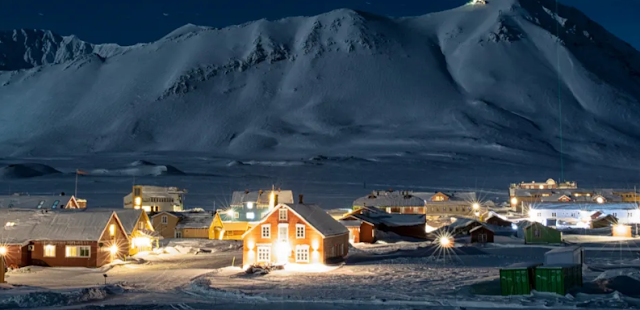The place with the purest air and no internet
There's a community in Svalbard where the air is ultra-clean, Wi-Fi is prohibited, and all buildings are left unlocked in case you need to hide from polar bears - however, as Anna Filipova discovered, huge changes are in the air.
With each breath, the air around me crackles with diamond-like particles. On this hillside in the middle of what is effectively an Arctic desert, it is chilly but clear. The incredibly dry, frigid air transforms the fog of moisture from my lips and nose into small, dazzling crystals of ice practically instantaneously.I'm standing right below the crest of Zeppelinfjellet, a 556m (1,824ft) mountain on Spitsbergen's Brggerhalvya peninsula in Svalbard, Norway's Arctic archipelago. Under me is the town of Ny-lesund, a little community with a winter population of 45 and a summer population of up to 150. It is the world's northernmost permanent community, located around 765 miles (1,231 kilometres) from the North Pole.
It is a stunningly gorgeous location, with a mountain rising on one side and a fjord on the other. It is also one of the greatest spots on the earth to take a breather, since it is located far from major sources of pollution in the practically pristine Arctic environment, and the air here is among the purest in the world.
The majority of the town's population are scientists who have moved here specifically for this purpose. To assist researchers in monitoring air pollution, a research station was established on Zeppelinfjellet's sides in 1989 at a height of 472m (1,548ft). The Zeppelin Observatory, as the research station is known, has lately become an important site for studying greenhouse gas levels that are causing climate change.
However, there are evidence that the air quality in this area is changing. At times, atmospheric currents transport air from Europe and North America to this portion of Svalbard, carrying pollution with them. Not only are researchers noticing higher amounts of some pollutants, but there are also hints of new forms of pollution being carried by the wind, which is causing concern among experts.
"The Zeppelin Observatory is located in a remote and pristine location, far away from significant pollution sources," explains Ove Hermansen, senior scientist at the Zeppelin Observatory and the Norwegian Institute for Air Research. "If you can quantify it here, you already know it has a global prevalence. This is an excellent position for studying the changing atmosphere."
The research in Ny-lesund is an important component of an international effort to map humanity's impact on the environment. According to Hermansen, the measurements they collect assist to "identify the baseline of pollution and quantify the worldwide trend over time."
Five days a week, a Norwegian Polar Institute employee ascends the cable car to the observatory to do maintenance, take air samples, and change filters on the equipment. The Zeppelin Observatory is a perfect position to help develop a picture of what is happening in the Earth's atmosphere because of its isolated location and height above air layers that can trap what little pollution is produced locally from the town. The sensors at the observatory monitor not just greenhouse gases but also chlorinated gases like CFCs, airborne heavy metals, organophosphate pollutants like insecticides, and pollution linked with burning fossil fuels including nitrogen oxides, sulphur dioxide, and particulates like soot.
The data they collect is then combined with measurements collected elsewhere by an international network of stations to create a global "background" of atmospheric gases, aerosols, and particles, providing a baseline against which pollution may be quantified.
"The monitoring here at the observatory covers a wide variety of topics," Hermansen, who has worked at the Zeppelin Observatory for more than two decades, adds. "Environmental toxins are particularly intriguing in terms of their biological consequences and the status of the Arctic ecosystem, whereas measurements of greenhouse gases and aerosols are particularly significant in terms of their impact on climate change."
Methane levels in the air surrounding Zeppelin, for example, have been rising since roughly 2005 and hit new highs in 2019. There is growing worry that human-caused methane emissions are jeopardising efforts to limit global warming to 1.5 degrees Celsius.
Radionuclides generated by the station's fission reactor were identified in the atmosphere in Zeppelinfjellet ten days after the Fukushima nuclear power plant catastrophe in 2011. It indicated that radioactive particles might travel hundreds of kilometres through the atmosphere in a matter of days.
During the summer months, the researchers at Zeppelin have also seen increases in the amounts of sulphate, particles, and metals such as nickel and vanadium in the air surrounding Ny-lesund due to an increase in the number of cruise ships visiting the area.




0 Comments